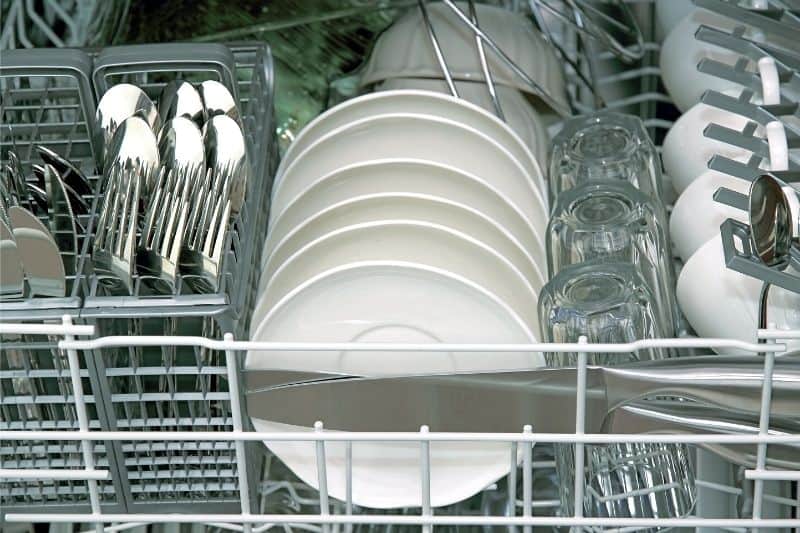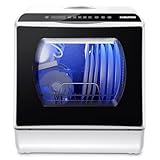Dishwashers are great appliances that many people (myself included!) swear by, but for some, a full-size under-counter dishwasher just isn’t an option.
Whether it’s a lack of space, or you’re renting and don’t want to buy and install a full-size dishwasher, there are many reasons why a full-size under-counter model just isn’t an option.
For those people, a tabletop dishwasher might be a better answer. Tabletop dishwashers are more compact and can be moved around (within reason) if needed.
One of the most common questions about tabletop dishwashers is regarding how they are installed.
Do Tabletop Dishwashers Need to Be Plumbed In?
Dishwashers need a fresh water supply and a route by which wastewater can be drained away. While tabletop dishwashers do need both a water supply and a drainage route, they don’t require the same type of plumbing as full-size versions.
There are tabletop dishwashers available that can be plumbed in with a semi-permanent or temporary setup.
Temporary plumbing
Temporary plumbing is an affordable solution that doesn’t require a plumber.
The exact process required depends on the model of the dishwasher. However, most temporary solutions use water from the tap via an inlet hose and drain wastewater away through a waste hose, usually positioned over the left-hand sink (when using dual kitchen sinks).
For some popular models, the safety supply hose is stored at the back of the dishwasher. When the machine is being used, this is removed, and one end is connected to the tap.
Sometimes you might find that you need to remove the aerator from the tap (the bit at the end of the tap where the water comes from) and replace it with one that matches the inlet hose.
If yours doesn’t fit, you can just take the hose to your local DIY shop and they should be able to help you pick out an appropriate aerator.
Once the hose is suitably connected to the tap, the other end of the hose is simply connected in the back of the machine. Once the wastewater hose is in position in the machine and over the sink, you’re ready to go.
Opting for temporary plumbing gives the benefit that you could store the dishwasher away, and only get it out when needed. This is especially helpful in smaller properties with limited workspace.
When picking out a space for a tabletop dishwasher though, make sure that you consider where the nearest plug socket is, and how you will get the hoses to the sink.
If the room allows, it is possible to install a tabletop dishwasher in a kitchen cabinet. If you do want to install a tabletop dishwasher in a cabinet, make sure that you consider the placement of the waste and inlet hoses before committing to a position.
Semi-permanent plumbing
When it comes to considering whether to plumb in a dishwasher with a semi-permanent plumbing solution, it may be useful to consider your washing machine.
Washing machines need clean water flowing in, and a way for wastewater to flow out.
Washing machines are usually fixed in place, and so a semi-permanent plumbing solution is used to provide water specifically to the machine. It also provides an eventual connection to the drainage system to dispose of the wastewater.
Full-size dishwashers are installed in this way, and tabletop versions can be too if desired. Opting for this plumbing solution would mean that you do not need to drag hoses across the kitchen to use the tap for the machine’s water supply.
For homeowners who want the convenience of a dishwasher but don’t need or have space for a full-size model, getting a tabletop dishwasher plumbed in might be a worthwhile consideration.
Having the machine plumbed in means that you can simply turn the machine on, pick the cycle, add detergent and walk away, rather than fiddling around setting up hoses.
Dishwashers That Don’t Need Plumbing
Karlxtom Compact Dishwasher
This portable dishwasher features five washing programs and one drying program. It has four place settings, so it’s big enough to wash a family of four’s dishes after a meal.
It has a built-in 5-litre water tank, which is useful if you can’t connect it to a tap. You also have the option of connecting it to a tap using a hose.
The dishwasher comes with a drain hose which you can use to drain the dirty water into the sink or a bucket if you can’t position it near a sink.
Think Gizmos TG916 Portable Dishwasher
This dishwasher from Think Gizmos is advertised as not needing any plumbing. You can choose to either connect it to a tap using a hose, or use the built-in 7.5-litre water tank.
Thanks to the water tank, this dishwasher could be a good option for camping or other situations where you don’t have access to a tap and sink.
The dishwasher offers five washing cycles including Quick Wash and Eco options.
Installing a Countertop Dishwasher
Countertop dishwashers are simple to install and even simpler to use. However, before you bring a brand-new countertop dishwasher home, there are three things to think about before you banish handwashing for good:
- Your countertop dishwasher will need access to the sink for water supply and drainage. The perfect spot to put a countertop dishwasher is close to a power outlet and the sink. Think ahead before choosing which machine is best for you.
- To complete your first cycle with your new countertop dishwasher you’ll need to thread the water inlet to the kitchen tap.
- If you’re connecting your hose to a tap that is lower down than your dishwasher, you’ll need a pump to keep the water flowing.
Benefits of a Tabletop Dishwasher
Tabletop or compact dishwashers are an ideal solution for situations where space is at a premium. They don’t take up very much space and can be placed on work surfaces, in cabinets or even on another home appliance.
The small size doesn’t come at a compromise either – tabletop dishwashers still boast the same performance and functionality as you would expect in an under-counter machine.
Compact dishwashers are also very economical – they don’t require a great deal of water to run, and they don’t use much electricity either. In terms of up-front costs, tabletop dishwashers are cheaper than full-size versions too.
Tabletop dishwashers can easily be installed at whatever operating height works for you. They can be installed low down like traditional dishwashers, or you can install them at counter height, saving on all the bending and leaning that comes with loading a dishwasher.
Cons of a Tabletop Dishwasher
Regardless of the size, a dishwasher is still a hefty investment, and so it is important that you make an informed decision.
When shopping for a tabletop dishwasher, you should consider how you will use the appliance. Their compact size means that there is unlikely to be any space for large dishes, huge pans and big baking trays.
Their small size means that they are better suited for families of two to three people with daily cycles so all the dishes can easily be cleared in just one or two cycles.
If you have a larger family, a tendency to use massive pots and pans or don’t want to run the dishwasher daily, it might be worth considering a full-size under-counter model.

Lover of coffee, painting, and all things cute and fluffy. I’m always on the lookout for easier, more gentle ways to tackle awful household chores.







